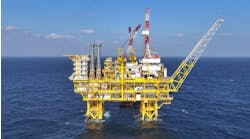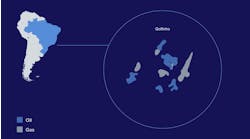Alba II, Parliament, Bressay, Clair, Britannia may bridge significant production plunge
Chevron Europe has few alternatives. Having sold its way out of the Ninian complex last year, the company is pinning its oil hopes on three large, but complex fields with exceptionally low gravity crude. Assuming the development barriers are breached, Chevron could be set for rising UK sector oil production in the next century, at a time when others, according to the company's managing director Bob Connon, "look like falling off the cliff".
In the nearest term, the company's toughest decision relates to its Alba Phase II development. The northern section of the Alba reservoir has been producing since 1993 via a platform exporting to a floating storage unit. Flow rates have not been ideal, due to a combination of well problems such as sand, scale and attempting to separate the field's heavy crude (20-API).
Debottlenecking of the platform's capacity, which involved installing a new production module last July, should have raised output nearly 20% to 100,000 b/d. The next challenges will be to bring the Parliament satellite (confirmed by a recent well as a worthwhile prospect) onstream as a subsea tieback; and more problematically, to exploit the reserves three miles to the south.
Extended reach wells from the North platform seem the probable solution - one has already been drilled with a 15,500 ft offset. The next stage, however, calls for 18,000 ft well offsets. That implies, said Connon, "that we'll have to double our technology against what was originally thought likely". To lessen the cost, Chevron will continue its policy of drilling two wells from the same slot on the platform.
Should extra capacity be needed to handle production from the ERD wells, a small platform bridge-linked to the main facility remains an option, Connon said. However, high levels of intervention necessary on the Alba wells to date look like militating against a separate subsea production center at Alba South, although he conceded that subsea injection wells probably would be needed.
Chevron plans further exploration close to Alba, but appraisal is the priority on Bressay, in block 3/28A. This is one of two known giant, but undeveloped oilfields, in the north of the UK sector: reserves are thought to be around 1 billion bbl. However, the location east of the Shetlands, remote from existing infrastructure, allied to the low gravity of the oil - 12- or less - have stalled further study until now.
"We're not really comfortable in knowing the characteristics of heavy oil," said Connon. To shed more light on production performance, two appraisal wells will be drilled in the reservoir this year (one likely to be an extended test). Studies will focus on fluid properties and refinability. Thom Garrett, Chevron's vice-president for international trading, pointed out that refineries in Europe are already altering their metallurgy to handle heavier crude from new fields such as Texaco's Captain and Mariner.
West of the Shetlands, the BP-operated Clair Field could be six times the size of Bressay. It has remained in virtual limbo since its discovery in 1977 for the same reasons: remoteness, poor producibility. However, an extended well test last summer proved very positive, said Connon: this garnered 500,000 bbl at a maximum flow of 18,000 b/d. Chevron, which is a 20% stakeholder in Clair, will help fund two further appraisal wells on the field this year.
If development does go ahead soon, it will likely be phased, he commented, to minimize the risk. 2000 was his suggested start-up date. Platform-based facilities with spare capacity would be convenient for Chevron, which sees this region as a possible new core area: it plans to drill four of its own exploration wells on acreage close to Clair in the next couple of years.
However, the approach is not exactly gung-ho. It concerned Connon that Chevron's equity in its west of Shetlands blocks was 40-80%, against 25-40% typically in other zones. "If we have a major discovery in one of these blocks, are we prepared to develop it with that big a risk?" Should Chevron farm in partners before or after a discovery? "One argument is that if you do it before, that gives you more shots at exploration."
Most of Chevron's remaining exploration budget in Northwest Europe will focus on the `frontier' region west of Britain and Ireland. A well is imminent off the St David's peninsula in Wales' Cardigan Bay, following acquisition of 2D seismic last year. More 2D seismic was shot over Ireland's Porcupine Basin, but Connon did not foresee drilling here by Chevron before 1999.
In the Central North Sea, Britannia, which is the UK's biggest new gas/condensate development, looks set for completion two months ahead of schedule and 10% under budget (?1.4 billion) in July 1998. Chevron cooperates the project with Conoco as Britannia Operator: the effect of this alias has been that neither company has received much credit for their achievements, Connon sighed.
Cashflow for upstream schemes was improved when Chevron agreed to sell its share of the Ninian Field to Oryx. Falling production meant that the field's value had dropped to just 10% of Chevron Europe's total portfolio, while occupying 50% of its workforce.
The sale has led to a much slimmer, more outsourced Chevron Europe, with UK staff being more than halved to 240. The London head office's remit, however, is broadening to growth through acquisition, although this is no easy option at the moment in Europe's upstream, according to Connon: "It's a seller's market in this area, making it as much of a risk as exploration."
Chevron's caution in Europe contrasts with other regions such as West Africa and the Gulf of Mexico, where the company is investing heavily in deepwater exploration, according to group vice-chairman Jim Sullivan. Chevron may also double its LNG capacity for the northwest Shelf project off Australia, he said, if agreement can be reached with the partners. A letter of intent has been received from Japan concerning expanded supplies.'
Copyright 1997 Offshore. All Rights Reserved.






